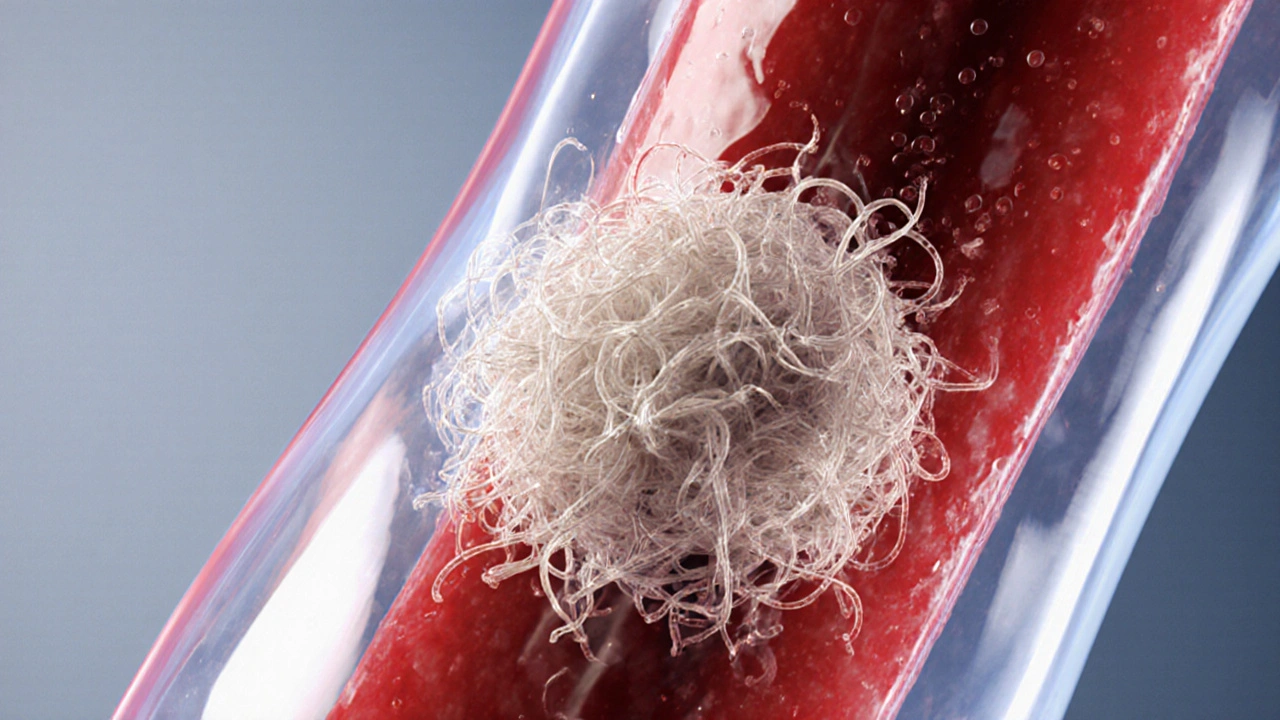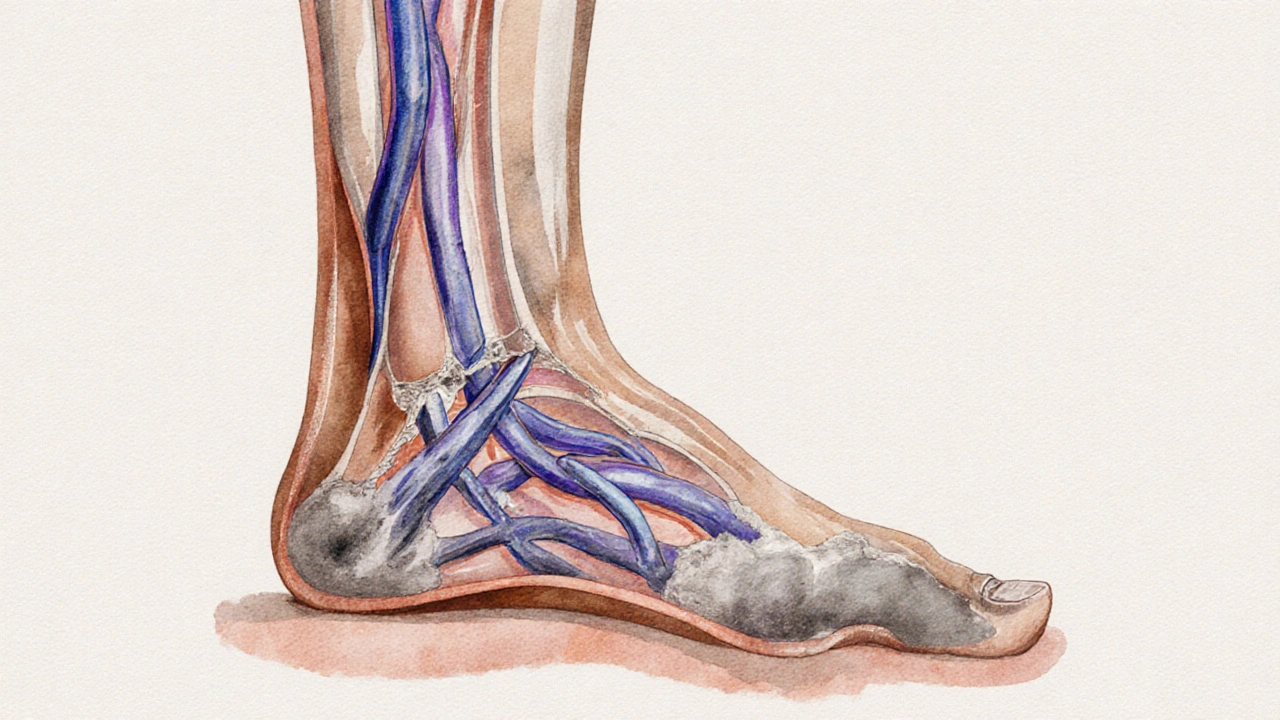Blood Clot Formation & Venous Insufficiency: How They’re Linked

Blood Clot & Venous Insufficiency Risk Checker
Assess Your Risk Factors
Answer the following questions about your lifestyle and medical history to get personalized insights.
Your Risk Assessment
Ever wondered why a simple clot can turn into a chronic vein problem? Understanding the bridge between blood clot formation and venous insufficiency helps you spot warning signs early and take action before a minor issue spirals.
What is blood clot formation?
When blood clot formation occurs, fibrin strands and platelets knit together to seal a breach in a blood vessel, the body is protecting itself from bleeding. This natural response becomes a problem only when clots block normal flow, especially in the deep veins of the legs.
Understanding venous insufficiency
Venous insufficiency is a condition where the veins struggle to push blood back toward the heart, leading to pooling and swelling. Faulty or damaged venous valves let blood leak backward, increasing pressure in the lower limbs.
Deep vein thrombosis (DVT) - the common culprit
Deep vein thrombosis refers to a clot that forms in the deep veins, usually of the thigh or calf. DVT is the most direct link between clotting and venous insufficiency because the clot can damage the vein wall and its valves, setting the stage for chronic insufficiency.
How clots damage veins and trigger insufficiency
When a clot lodges in a deep vein, the pressure behind it rises. The vein wall stretches, and the surrounding venous valve acts like a one‑way gate that can become scarred or deformed. Even after the clot dissolves, the scarred valve may never close fully, allowing blood to flow backward (reflux). Over months, this reflux creates the classic signs of venous insufficiency: varicose veins, edema, and skin changes.

Varicose veins and other visible signs
Variclet veins are twisted, bulging surface veins that often appear after deep vein damage. They’re not just cosmetic; they signal that deeper veins are struggling, and they can bleed or ulcerate if left unchecked.
Risk factors that drive both clotting and insufficiency
- Prolonged immobility (long flights, desk jobs)
- Obesity - excess weight presses on leg veins
- Pregnancy - hormonal shifts increase clotting tendency
- Smoking - damages vessel walls and speeds up clot formation
- Previous DVT or family history of thrombophilia
Notice how these factors overlap? That overlap explains why many people who develop DVT later suffer from venous insufficiency.
Symptoms to watch for
- Sudden calf pain or swelling - could be an acute clot
- Heaviness, aching, or tightness in the leg - early sign of reflux
- Skin discoloration (brownish patches) around the ankle
- Visible varicose veins that worsen after standing
- Night cramps or restless legs
How doctors diagnose the problem
First, a clinical exam checks for tenderness, edema, and visible veins. Then, imaging steps in:
- Doppler ultrasound - visualizes blood flow, detects clots, and measures valve function.
- Venography (rare) - injects contrast to map the vein network.
- Blood tests for clotting disorders (e.g., Factor V Leiden).
These tools help differentiate a fresh clot from chronic insufficiency, guiding treatment.

Management strategies - tackling both sides
Depending on whether you’re dealing with an active clot, chronic insufficiency, or both, treatment varies.
For acute clotting (DVT)
Anticoagulants such as warfarin, rivaroxaban, or apixaban thin the blood to prevent clot growth are the cornerstone. Therapy typically lasts 3‑6 months, followed by a reassessment.
For chronic venous insufficiency
Compression therapy involves wearing graduated stockings that squeeze the leg, encouraging upward flow reduces swelling and pain. Compression levels range from 15‑20 mmHg for mild cases to 30‑40 mmHg for severe reflux.
Additional options include:
- Leg elevation and regular walking to boost calf muscle pump.
- Weight loss programs to lessen venous pressure.
- Minimally invasive procedures (endovenous laser ablation, radiofrequency) that close faulty veins.
- Skin care for ulcer prevention - moisturize, keep wounds clean.
Comparison: Blood clot vs Venous insufficiency
| Aspect | Blood clot formation (DVT) | Venous insufficiency |
|---|---|---|
| Primary cause | Hypercoagulable state, stasis, vessel injury | Faulty venous valves, increased venous pressure |
| Onset | Sudden, often painful | Gradual, aching heaviness |
| Typical symptoms | Calf swelling, warmth, red streaks | Varicose veins, edema, skin discoloration |
| Diagnostic test | Doppler ultrasound (detects thrombus) | Doppler ultrasound (assesses reflux) |
| First‑line treatment | Anticoagulants | Compression therapy |
| Long‑term risk | Post‑thrombotic syndrome (may lead to insufficiency) | Ulceration, chronic edema |
Living with the combined threat
If you’ve experienced a DVT, keep an eye on your legs for months afterward. Persistent swelling, discoloration, or new veins warrant a follow‑up Doppler exam. Early detection of post‑thrombotic changes can prevent full‑blown insufficiency.
Conversely, if you already have venous insufficiency, avoid prolonged immobilization and discuss prophylactic anticoagulation with your doctor if you have other clot‑risk factors.
Remember: lifestyle tweaks-daily calf raises, brisk walks, staying hydrated-are free tools that support both clot prevention and vein health.
Quick checklist for proactive leg health
- Move every 2 hours during long trips or desk work.
- Wear graduated compression stockings if you have varicose veins or a history of DVT.
- Maintain a healthy weight (BMI < 25) to lower venous pressure.
- Quit smoking - it harms vessel walls and raises clot risk.
- Stay hydrated; low fluid intake thickens blood.
- Schedule an annual leg exam if you’ve had a clot or chronic venous disease.
Frequently Asked Questions
Can a blood clot cause varicose veins?
Yes. A clot that damages a deep vein’s wall or valve can lead to reflux, which eventually produces varicose veins on the surface.
How long after a DVT should I wear compression stockings?
Most physicians recommend at least 6‑12 months, or until a follow‑up ultrasound shows no residual reflux.
Is it safe to exercise if I’ve had a recent clot?
Gentle, low‑impact activities like walking or swimming are encouraged, but high‑intensity sports should be cleared by your doctor.
What are the warning signs of post‑thrombotic syndrome?
Persistent swelling, skin discoloration, aching heaviness, and the emergence of new varicose veins after a clot are key indicators.
Can I prevent venous insufficiency without medication?
Lifestyle measures-regular movement, weight control, compression stockings, and staying hydrated-are highly effective, especially when started early.
Rebecca Ebstein
Hey folks, great rundown! I love how you break down the clot‑vs‑vein stuff in simple steps. Keep moving, stay hydrated, and don’t forget those little leg lifts. You’re on the right track, just keep the positivity rolling!
👍
Artie Alex
While the preceding optimism is commendable, the pathophysiological cascade warrants a more rigorous exposition. The synergistic interplay between stasis, endothelial injury, and hypercoagulability-a triad epitomized by Virchow-cannot be trivialized. Moreover, the hemodynamic repercussions post‑thrombus dissolution necessitate a granular audit of valvular competence. In absence of such granularity, the discourse remains superficial.
abigail loterina
Thanks for the thorough info! If anyone’s feeling overwhelmed, just remember to take it one step at a time. Small changes like short walks every hour can make a big difference. You’ve got this, and we’re all here to cheer you on.
Roger Cole
Even a 5‑minute stretch helps.
Krishna Garimella
When we contemplate the microcosm of a clot forming in a vein, we are really peering into the delicate balance of nature’s own engineering. The coagulation cascade, with its cascade of proteases, is both a guardian and a potential saboteur, stepping in to seal a breach yet sometimes overstepping its mandate. Imagine a tiny plug lodged deep within the femoral vein; the immediate consequence is a surge in upstream pressure, a phenomenon that reverberates through the venous network like a ripple in a pond. This pressure forces the venous valves, those unassuming one‑way doors, to stretch beyond their elastic limits, introducing microscopic tears that never fully mend. Over weeks and months, those microscopic injuries coalesce into scar tissue, effectively blunting the valve’s ability to close. The resultant reflux permits blood to pool, manifesting as the characteristic heaviness and swelling described in the article. As the stagnant blood lingers, it becomes a fertile ground for further inflammation, perpetuating a vicious cycle of damage. Philosophically, this mirrors how a single unaddressed issue in any system can cascade into systemic failure unless corrective action is taken promptly. Clinically, this underscores the importance of early doppler assessment after a DVT event, to catch lingering reflux before it matures into chronic insufficiency. Lifestyle interventions-regular calf muscle contractions, weight control, and avoidance of prolonged immobility-serve as the gentle nudges that keep the circulatory river flowing. Compression stockings, though sometimes maligned for their inconvenience, act as external scaffolding, supporting the compromised venous walls. In societies where sedentary work is the norm, the collective burden of venous disease silently rises, demanding public health attention. Yet hope lies in education: when people understand the simple mechanics of "move every two hours," they empower themselves against the tide of post‑thrombotic syndrome. Ultimately, the interplay between clot and vein is a dialogue-one that can end in harmony if we listen and intervene wisely. So, treat each clot not as an isolated event but as a potential herald of future venous health challenges, and act accordingly.